Ode to the Skunk Cabbage
The fragrance of the western skunk cabbage emerges like a thin mist from the early spring forests and swamps of north Idaho. It's a harbinger of spring here in our bio region, and this old friend catches my eye with its vivid green leaves and alerts me to the coming of spring with its unique scent. The sheer sight of this wild plant evokes the landscape from which it comes. Swampy wetlands with huge lush green leaves packed in everywhere. Although I live in north Idaho, I often feel I'm in the jungle when I go out to forage for this amazing plant.
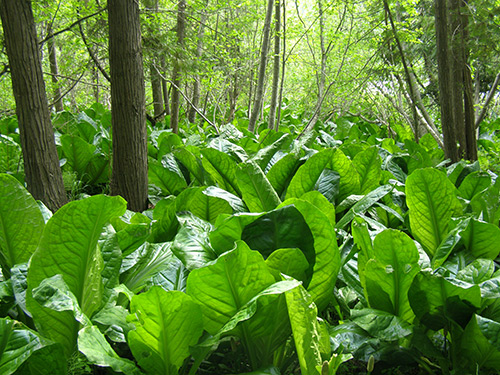
True to its name, the skunk cabbage (Lysichiton americanus) emits a "skunk" like odor from its leaves, flowers, spadix, spathe, rhizome and roots. For those of you not fond of this distinct smell, plug your nose and let's look a little closer. Those huge leathery leaves, vibrantly green and oval can grow to 3 feet in size. We've often used them as a "primitive tinfoil" for steaming vegetables and baking chicken.
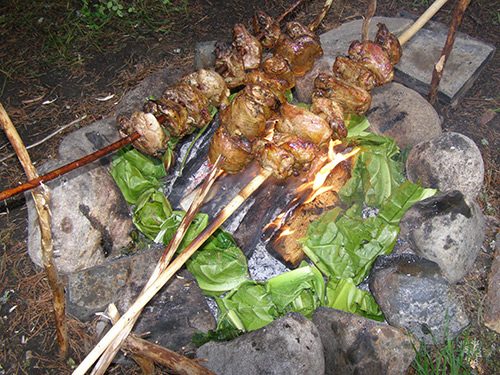
The greenish yellow spadix, long and tubular is hooded by an even brighter yellow spathe and the roots resemble the miniature head and arms of an octopus. No exaggeration!
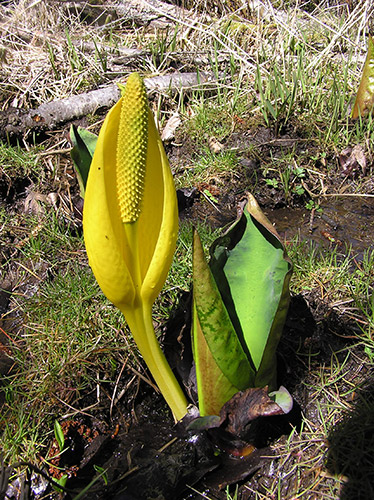
Skunk Cabbage Inspiration
Many years ago an inspiration began brewing for me upon reading Doug Elliot's book Roots - An Underground Botany and Forager's Guide. This wild plant is featured therein. After reading about this plant and seeing its illustration I knew that ancient underground secrets lied within its primordial roots just waiting to be dug up and discovered. The thing is I've found one needs to have some time on their hands as it can take several hours to dig up the roots.
One balmy spring day the Twin Eagles Wilderness Immersion Program staff and adult students participated in an intensive training on wild edible and medicinal plants and dug up the roots to see for themselves. I had told them we would be making an ointment from the roots and that the healing balm of this root alleviates the pain of exterior open sores and wounds, blisters and broken skin, fungal infections and skin tumors. It is powerful medicine.
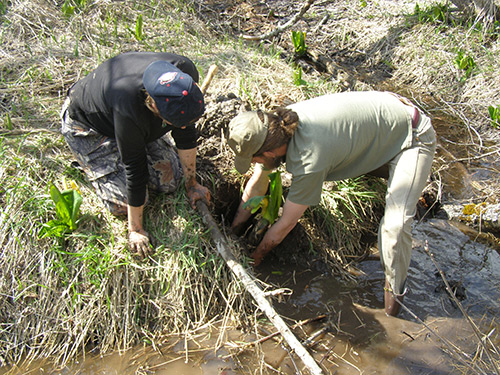
Needless to say they were excited to get digging. Who could pass up an opportunity to unearth an herbal remedy that could do all that? The total digging time, pulling away of mud and excavation of the rhizome and roots took almost three hours! Just for one plant! While the roots of the skunk cabbage held onto the mud with a vengeance, persistence paid off.
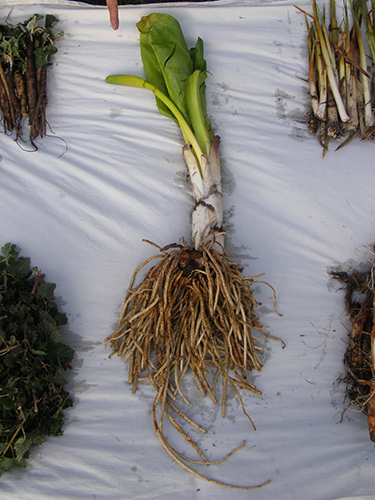
After harvesting the roots and having washed them well we chopped them all up (resembling squid at this point) and packed them in a pint jar of olive oil for four weeks.
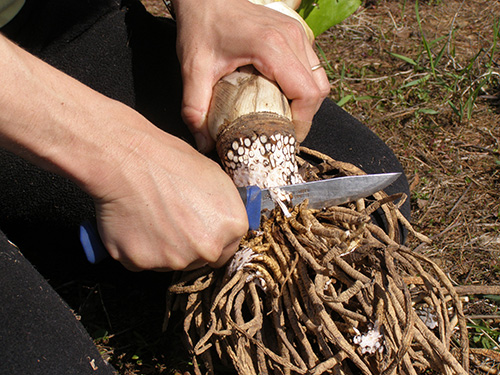
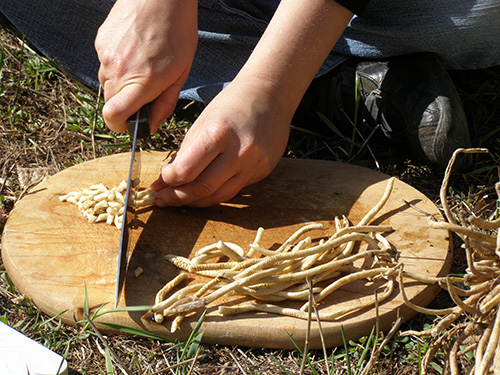
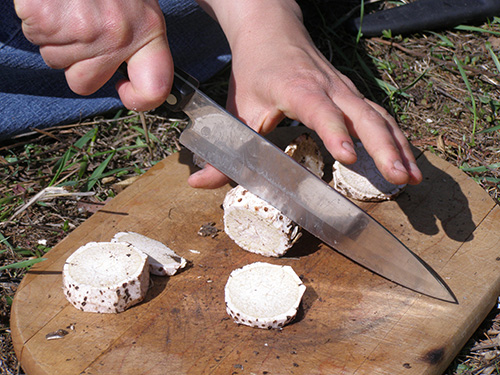
Then we strained the roots and heated the oil (1/4 cup worth) in a pan, adding in ½ oz. of beeswax. Once the beeswax melted and mixed in sufficiently we poured the concoction into salve jars and waited for the ointment to solidify. We were anxious to use this healing balm, if only we had an ailment!
There are many external uses of this noteworthy plant. As well, there are a variety of ways to work with the plant including using the burned roots as a smoke and as a fresh poultice. Other uses include making a wash with the root hairs to stop external bleeding, using the roots to reduce painful swellings, and making leaf poultices to pull out thorns and splinters.
Poisonous Look-a-Likes
There is a deadly look-a-like that is important to be aware of. On the surface, false hellebore (Veratrum viride)bears a resemblance to skunk cabbage and can easily be mistaken as such. These plants can grow up looking like an encased collection of green leaves before they branch out fully. When they are in this stage they can have that hooded skunk cabbage appearance as their leaves can grow quite large, green and from a distance, look like they generally have the same shape. That said, false hellebore leaves look crimped and pleated with obvious parallel veins and are pointed at the ends. The leaves of the skunk cabbage have more inconspicuous veins on their leaves and are branching instead of being parallel. The leaves are rounded at the end.
Besides the false hellebore being deadly and these two plants often growing near each other, the skunk cabbage leaf, flower and roots contains calcium oxalate crystals which irritate the mouth and throat causing a burning sensation in the mouth, throat and on the tongue. Skunk cabbage should not be eaten raw. While there are traditional recipes that advise changing the water several times to boil out the oxalate crystals before eating this plant, it's important to know that overeating of this plant causes nausea, stomach irritation and diarrhea. Ouch!
Resources for Learning More
There are so many great resources on medicinal plants. While medicinal plants date back to at least the Paleolithic times, it's amazing to think that since then there has been and continues to be so much written about medicinal plants. First, for more information I encourage you to check out our other articles on Herbal Remedies and Medicinal Plants. As well, here's a great list of books that feature not only skunk cabbage but many other incredible medicinal plants.
- Wild Roots: A Forager's Guide to the Edible and Medicinal Roots, Tubers, Corms and Rhizomes of North America by Doug Elliot
- The Secret Teachings of Plants: The Intelligence of the Heart in the Direct Perception of Nature by Stephen Harrod Buhner
- Peterson Field Guide to Western Medicinal Plants and Herbs by Christopher Hobbs and Steven Foster
An Ancient Lineage
As you continue on the journey of learning about medicinal plants and gathering them where ever you may go, remember that you are a part of a legacy and a tradition of herbal medicine that goes back thousands of years. You might be an amateur forager just beginning the journey of edible and medicinal plants or you might be more experienced having gone out to gather numerous times. It's powerful to think of the many earth based cultures who have gathered and used this same plant for many things from using the leaves as a pain relieving poultice on cuts and swellings to mashing up and inhaling the smell of the leaves to relieve headaches.
You are experiencing the ritual of gathering medicinal plants firsthand as your ancestors did long ago and that's something to appreciate. So before you go out and begin unearthing and digging up the skunk cabbage and other wild medicinal plants, remember to give thanks for all those who have come before who have handed us this important knowledge about the medicine plants. Enjoy the journey!
Interested in being personally mentored in Herbal Remedies & Medicinal Plants, on a transformational journey of connection to nature, community, and self?
Check out the Twin Eagles Wilderness Immersion Program.
comments powered by Disqus
Return from Skunk Cabbage to Online Herbal Remedies Advice
Return from Skunk Cabbage to Wilderness Survival (homepage)
Track Us